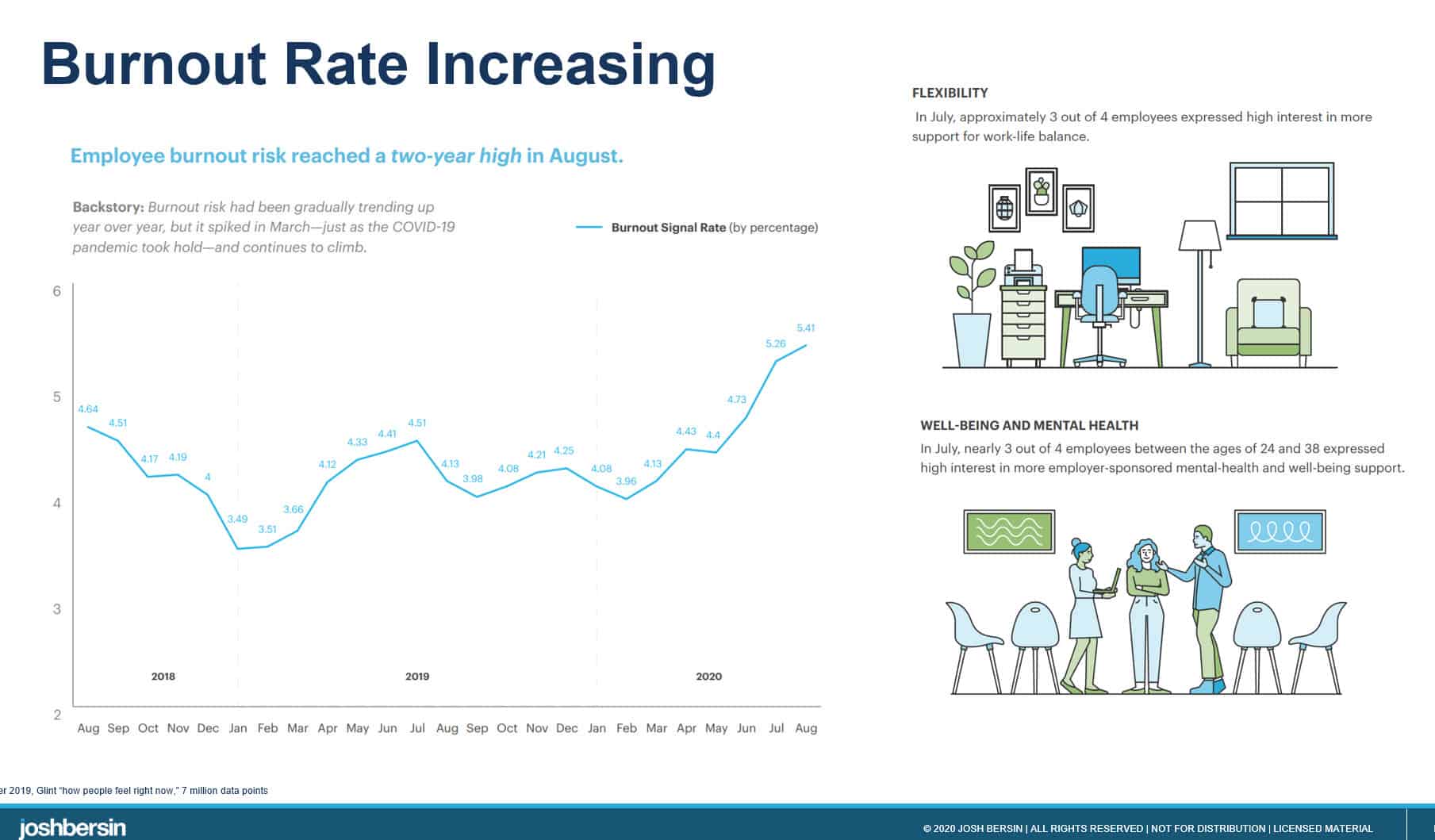Feeling Burned Out? We All Are. Why This Is A New (And Old) Problem
Burnout is one of the biggest topics in the new world of work. In fact, it’s almost a fad to talk about it. People are tired, we have “zoom fatigue,” and last year the World Health Organization actually classified burnout as a disease.
What is burnout? According to the WHO it includes “feelings of energy depletion or exhaustion,” or “feeling of negativism or cynicism about one’s job.” And when you’ve been stuck at home for a year, unable to get on a plane and travel, or on conference calls all day – you feel it. (I know I do!)
Glint’s latest research, which analyzed more than 7 million employee feedback questions, shows that burnout is at an all-time high. A recent Harvard study of 1500 business people found that 89% of employees believe their work-life is getting worse, 85% said their wellbeing had declined, and 57% believe the pandemic has “completely dominated” their work. New Financial Times research shows that 38% of Brits are “highly anxious” and 28% are “lonely most of the time.”
 |
And we aren’t all experiencing it the same way. Nurses and healthcare workers are enduring long hours, low pay, and health risk. Teachers are frustrated that they can’t interact closely with their pupils. Tech and white-collar workers are tired of sitting in front of their computers.
But let’s be honest. This is NOT a new problem.
I first wrote about burnout in 2014 in the article “The Overwhelmed Employee.” During that research, I discovered that almost half of all employees work more than 50 hours per week and that 80% of workers would like to work fewer hours. So this problem, which feels like an epidemic now, has actually been around a very long time.
In fact, I would argue that there were probably people getting burned out hundreds of years ago too. The railroad workers around the turn of the century, the sweatshop workers in the 1920s, and of course the underpaid retail workers before minimum wage – they were burned out too.
So let’s stop talking about technology, video tools, or emails. The real issue with burnout is making work meaningful, purposeful, and possible. What burns people out the most is “not being able to get the job done.” Because when you “finish” something you feel good about your work – if, of course, your boss thanks you.
So let me give you a simple solution. Avoiding and preventing burnout takes six things. And these are solutions that apply regardless of company, job, or industry:
- Meaningful work. Is the job itself a “good job.” Can you as an individual put your own energy into the job? Are the hours reasonable? Is it a good fit with your interests? Are your teammates helpful?
- Hands-on management. Is your boss, manager, or team leader someone who cares? Does management clarify what’s important and what’s not? And will they listen to your input? Today management is all about “doing less” not “doing more.” Help people focus.
- Positive work environment. Do you have the tools you need to get work done? Do people appreciate you? Do you feel that you belong? Do you have the flexibility to work your own way? (Say thank you – people who feel appreciated have a 30% lower burnout rate!)
- Health, safety, and wellbeing. Is the workplace safe, productive, and healthy? If you’re working at home can you see your computer ok? Is your chair comfortable? Is the workplace virus-free?
- Ability to grow. Is your job taking you somewhere? Are you learning something? Are there mentors or role models to help you grow? Is there a future in the company? These things give you inspiration, energy, and passion.
- Trust and purpose from leadership. Finally, and maybe most important of all, does leadership paint a vision you believe in? Do you trust them? Do they care about you? A sense of purpose gives people energy, enthusiasm, and endurance.
 |
I’ve spent many years studying jobs, work, technology, and HR. The issues of “burnout,” as real as they feel, are not hard to solve. You just have to think about these six things, and don’t be afraid to make changes.
Design work so it’s achievable. Train managers to coach and help others. Create a safe and productive work experience. Make sure training and development is available. And focus leadership on mission, purpose and trust.
If you really want to get under the covers of all this, join our new Employee Experience Crusade. This research, which we will publish in Q2, will show you precisely what other companies are doing to nail the “burnout problem.”
Yes, the pandemic is a drag. But for most of us, work can be the most enjoyable part of our lives. Let’s all work on making it better.
PS. Join me next week with Webex as I uncover some of what we’ve learned, in a special webinar on The New Future of Work.
More Resources on Burnout, EX, and More
Our Big Reset Research – detailed reports on what we learned from the Pandemic, going back to work, and business transformation.
Elevating Equity: What Really Works in DEI – our latest study which uncovers the truth about DEI strategies and investments.
HR Technology 2021: The Definitive Guide – everything buyers, vendors, and investors need to know about HR Tech for 2021.
The Josh Bersin Academy – “The World’s Home for HR” – join more than 30,000 HR professionals to learn about EX, public health, technology, and more.
Pandemic Response: Building Resilience – the most in-depth study of ten best practices for business resilience.


